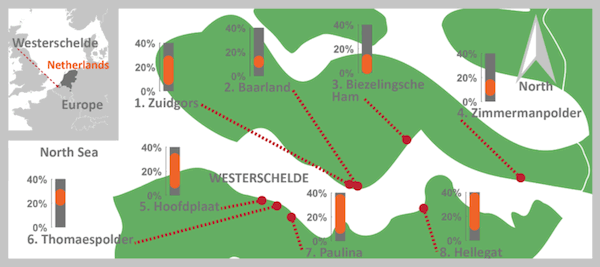Willemsen, P.W.J.M.1,2,3, Borsje, B.W.1, Vuik, V.4,5, Bouma, T.J.2, Hulscher, S.J.M.H.1
1 University of Twente, This email address is being protected from spambots. You need JavaScript enabled to view it., 2 NIOZ and Utrecht University,
3 Deltares, 4 Delft University, 5 HKV
Dikes with foreshores (salt marshes and tidal flats) in front of it are proposed as sustainable and cost-effective solutions for coastal defence in the Scheldt estuary (Broekx et al., 2011). Within the Westerschelde, bed level measurements indicate a stable salt marsh and a relative stable or accreting tidal flat on time scales of months to a single year (Willemsen et al., 2018), thereby providing a sustainable coastal defence measure. However, the reliability of the wave attenuating capacity of foreshores in the Westerschelde on the design life time of coastal defence infrastructures (50 years) is not known and implementation is therefore hampered (Bouma et al., 2014). This study aims to quantify the long-term (50+ years) wave attenuating capacity of foreshores in the Westerschelde.
The wave attenuating capacity of eight foreshores in the Westerschelde was assessed using SWAN (Simulating WAves Nearshore; Vuik et al., 2016), over the past 60 to 70 years. Bathymetrical data stored in the “Vaklodingen” was converted to transects parallel to the design wave direction (i.e. direction from where the highest waves possible occur). Vegetation was assigned to the higher parts of the transects, starting at Mean High Water Neap and represented by an appropriate Nikuradse roughness length (Vuik et al., 2019). The wave attenuating capacity for all transects was assessed for specific design conditions (recurrence time of 1/10000 year).
The wave attenuating capacity under design conditions over the past 50+ years shows spatial variability over a single foreshore (Fig. 1). The spatial variability at the southern shores of the Westerschelde is larger than at the northern shores. In general, the wave attenuating capacity at the southern shores is larger. Although natural dynamics affect the shape and environmental settings of foreshores, foreshores consistently contribute to coastal safety over the design lifetime of coastal defence infrastructures.

Figure 1. Minimum wave attenuation for eight foreshores in the Westerschelde. The minimum wave attenuating capacity of every transect is summarized per foreshore (orange bar).
References
Bouma, T. J., van Belzen, J., Balke, T., Zhu, Z., Airoldi, L., Blight, A. J., . . . Herman, P. M. J. (2014). Identifying knowledge gaps hampering application of intertidal habitats in coastal protection: Opportunities & steps to take. Coastal Engineering, 87, 147-157.http://dx.doi.org/10.1016/j.coastaleng.2013.11.014.
Broekx, S., Smets, S., Liekens, I., Bulckaen, D., & De Nocker, L. (2011). Designing a long-term flood risk management plan for the Scheldt estuary using a risk-based approach. Natural Hazards, 57(2), 245-266.10.1007/s11069-010-9610-x.
Vuik, V., Borsje, B. W., Willemsen, P. W. J. M., & Jonkman, S. N. (2019). Salt marshes for flood risk reduction: Quantifying long-term effectiveness and life-cycle costs. Ocean & Coastal Management, 171, 96-110.https://doi.org/10.1016/j.ocecoaman.2019.01.010.
Vuik, V., Jonkman, S. N., Borsje, B. W., & Suzuki, T. (2016). Nature-based flood protection: The efficiency of vegetated foreshores for reducing wave loads on coastal dikes. Coastal Engineering, 116, 42-56.http://dx.doi.org/10.1016/j.coastaleng.2016.06.001.
Willemsen, P. W. J. M., Borsje, B. W., Hulscher, S. J. M. H., Van der Wal, D., Zhu, Z., Oteman, B., . . . Bouma, T. J. (2018). Quantifying Bed Level Change at the Transition of Tidal Flat and Salt Marsh: Can We Understand the Lateral Location of the Marsh Edge? Journal of Geophysical Research: Earth Surface, 123(10), 2509-2524.doi:10.1029/2018JF004742.










